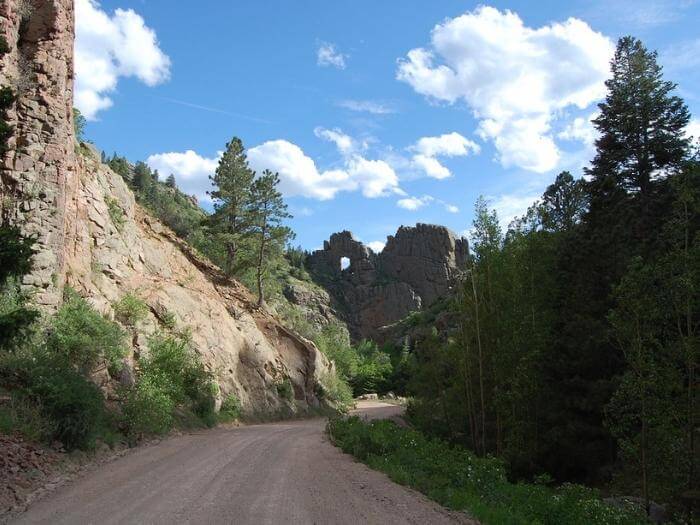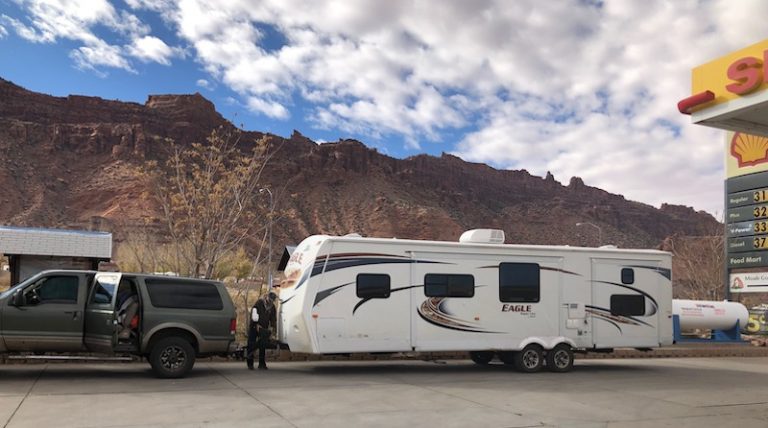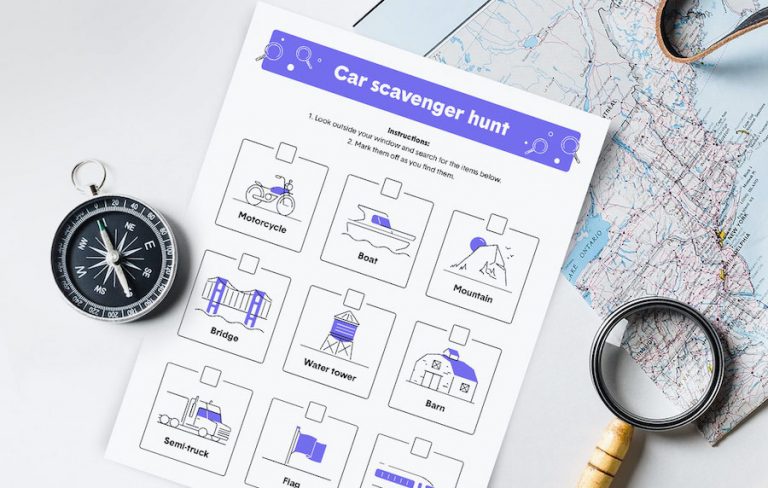Roads to Avoid in Colorado with an RV (and Which to Drive Instead)
NOTE*** The content on this page may contain affiliate links, we may make a commission. And, as an Amazon Associate, we earn from qualifying purchases. More information: disclosure page.
If you’re planning to go on an RV trip in Colorado, you should know about the roads. With the challenges of both cities and mountains, you need to know how to drive safely before you set out. Let me help you have the best and safest trip with this helpful list of routes you should avoid and which RV-friendly roads to take when RVing in Colorado.
I have lived in Colorado my whole life and have driven almost every road in this beautiful state. I have my fair share of RV trips myself with my family. Based on our experiences, here are 8 scary roads you should avoid with an RV and 3 routes you should take an RV drive instead.
Before we get started – if you want to avoid the possibility of driving any of these scary roads in Colorado, you can have an RV delivered. Read how to do that on our article here Have an RV delivered and set up at your campsite
Dangerous Roads You Should Avoid When RVing
Oh My God Road near Idaho Springs, Colorado
If you’re not a local or you don’t have much driving experience on mountain passes, better steer clear of Oh My God Road in Idaho Springs. This route got its name for its drop-offs and switchbacks. And despite being a two-way road, it is only about 1 1/2 cars wide. That leaves very little room for maneuvering an RV.
- Highway: State Highway 119
- Length: 8.1 mi | 13.04 km
- Height: 9,383 ft
Shelf Road between Canon City to Cripple Creek, Colorado
Shelf Road is a part of the byway going through the Fourmile Canyon. It is an unpaved path carved out of the side of cliffs. Even though it is a two-way road, in many places it can only be just as wide as a single vehicle.
- Highway: Gold Belt Byway
- Length: 24.4 mi | 38 km
- Height: 6,900 ft
Old Fall River Road near Estes Park, Colorado
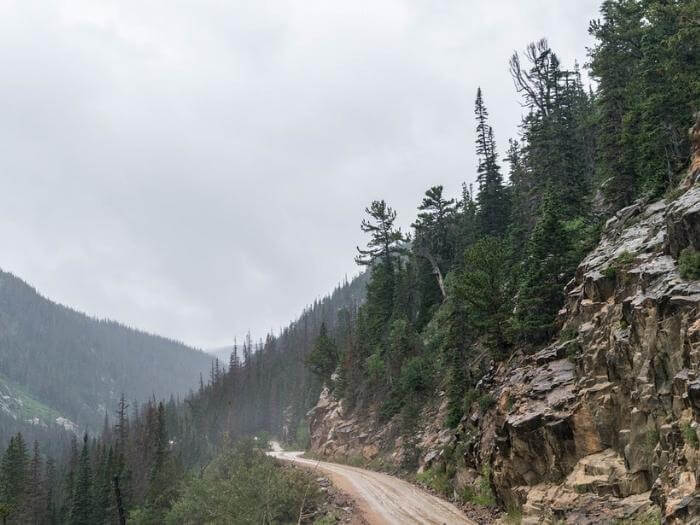
When traveling with an RV in Colorado, you can’t miss the popular Rocky Mountain National Park. But, it’s best not to take your RV up the Old Fall River Road. This gravel road was built in 1921 and has narrow lanes with no guardrails. It is also a one-way uphill and has a lot of switchbacks.
- Highway: U.S. 34
- Length: 11 mi | 17.70 km
- Height: 11,796 ft
- Speed Limit: 15 mph
Trail Ridge Road through Grand County and Larimer County, Colorado
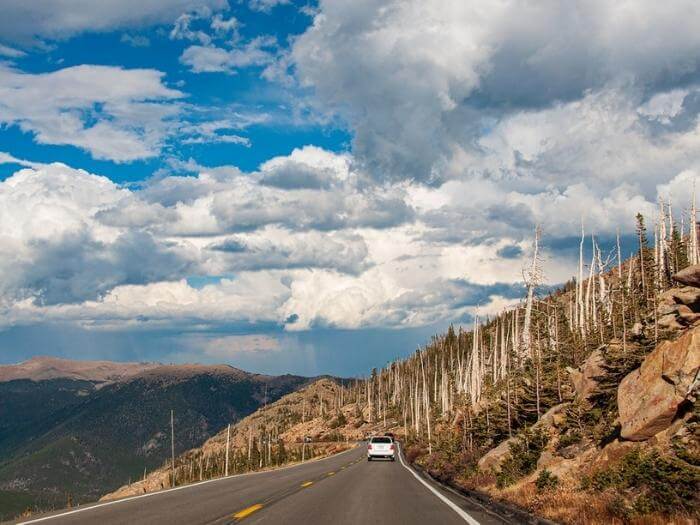
According to the National Park Service, Trail Ridge Road is a heavily traveled highway of Rocky Mountain National Park. It is also the highest paved road in Colorado.
Though it offers exceptional scenic views, it can be a dangerous route to take on your RV, especially if you’re a beginner in driving to steep mountain passes.
- Highway: U.S. 34
- Length: 48 mi | 77.25 km
- Height: 12,183 ft
- Speed Limit: 15 mph
Interstate 70 from Cove Fort, Utah, to Baltimore, Maryland
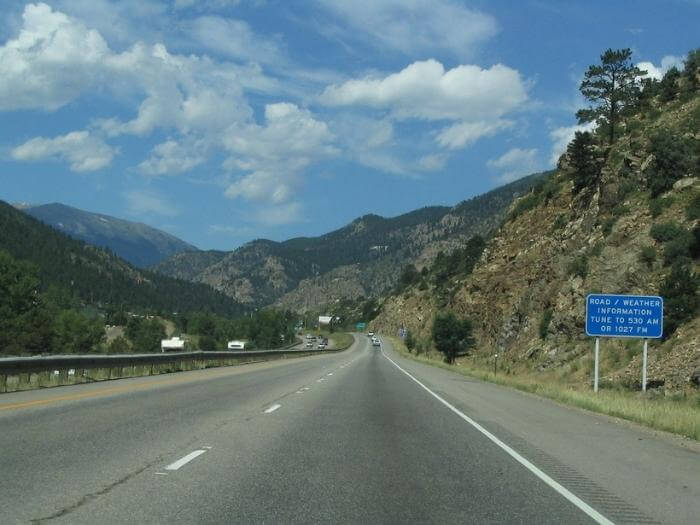
Ok, so I admit, this isn’t really fair since if you plan to go anywhere east to west in Colorado you will likely be in the interstate. However, I think it is worth noting the dangers of I-70 in an RV.
While it has exceptional mountain views, I-70 can also be steep and rough in many places. It also has several places where you’ll find 5 – 6% grades of mountain passes that stretch for many miles. There are turnouts for run-away trucks (and RVs) but you never want to have to use this, so make sure to stay in low gear and keep your brakes cool. Make sure to read our tips at the end of the post for driving safely on these roads.
If you go on a road trip along with Colorado, you will likely be on this road as it is the main highway through the state. When you pass by here, just make sure to proceed with caution.
Pro tip: Winter brings chain laws. You may be required to carry chains with you in case a storm begins. Check COtrip.org for details before heading out.
- Highway: Interstate 70
- Length: 2,151 mi | 3,462 km
- Height: 11,158 ft
Below are two mountain passes at I-70:
- Eisenhower Tunnels – Elevation: 11,158 ft
- Vail Pass – Elevation: 10,666 ft
Million Dollar Highway between Silverton and Ouray, Colorado

Highway 550 also known as the Million Dollar Highway was built in the late 1800s as part of the San Juan Skyway. Dangerous Roads listed it as one of the spectacular drives in America with scenic and jaw-dropping views.
As much as it is beautiful, it can also be dangerous for an RV drive, encompassing three steep mountain passes with hairpin curves and narrow lanes.
- Highway: U.S. Route 550
- Length: 25 mi | 40 km (in Colorado)
- Speed Limit: 10 – 25 mph
Here are the three mountain passes at the Hwy 550 route:
- Red Mountain Pass – Elevation: 11,018 ft
- Molas Pass – Elevation: 10,910 ft
- Coal Bank Pass – Elevation: 10,640 ft
State Highway 149 in southwestern Colorado
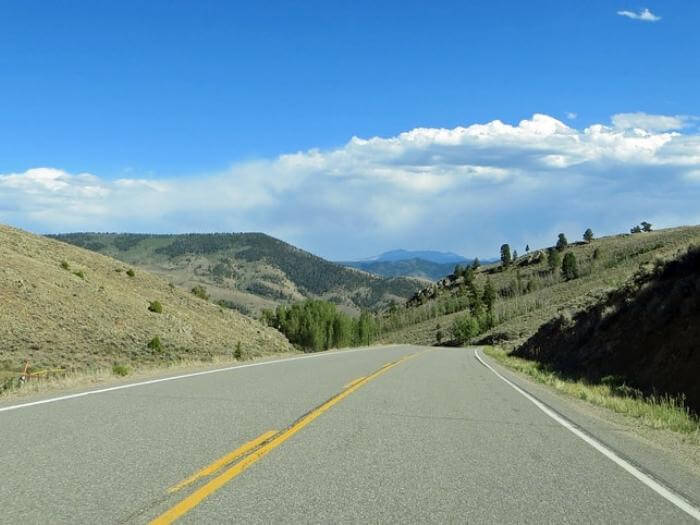
Much like any other roads with mountain passes and cliff drives, the State Highway 149 isn’t advisable for RVers who have little experience maneuvering steep and narrow mountain passes. It has hairpin curves at several places, narrow lanes, and switchbacks.
You will likely drive this highway to get to Creede, one of our favorite places in the state. We wrote about our favorite things to do in Creede here.
- Highway: SH 149
- Length: 117.50 mi | 189.1 km
- Height: 11,530 ft
Here are two known mountain passes at SH 149:
- Slumgullion Pass – Elevation: 11,361 ft
- Spring Creek Pass – Elevation: 10,901 ft
Independence Pass south of Aspen, Colorado
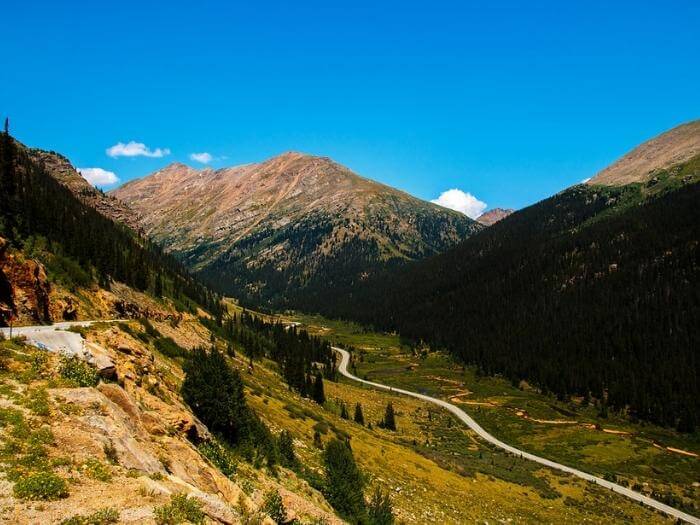
Independence Pass is formerly known as Hunter Pass. It is a high mountain pass just south of Aspen in Central Colorado. While some may argue that it is safe to pass by this road, it is not advisable for beginners who are just learning to drive an RV.
The steep and narrow road is not for the faint of heart. Especially that the highest elevation for this road is 12,095 ft.
Note that vehicles over 35 feet are not allowed on this road as it twists around and is narrow at some point. Only small campervans and tiny travel trailers can pass this length limit.
If you do pass by here, make sure to bask in the view of the aspen trees and stunning groves along the Roaring River Fork. Check out our favorite things to do in Aspen here.
- Highway: Colorado 82
- Length: 32 miles
- Height: 12,095 ft.
Grades and Elevation on Mountain Passes in Colorado
| Name | Highway | Summit Elevation | Maximum Grade |
| Trail Ridge Road | U.S. 34 | 12,183 ft. | 5.4% |
| Old Fall River Road | U.S. 34 | 11,796 ft | 6% |
| Slumgullion Pass | SH 149 | 11,361 ft. | 9.4% N; 7.9% S |
| Eisenhower Tunnels | I-70 | 11,158 ft | 6% W |
| Red Mountain Pass | Hwy 550 | 11,018 ft | 7%+ |
| Molas Pass | Hwy 550 | 10,910 ft | 7% + |
| Spring Creek Pass | SH 149 | 10,901 | 7.5% |
| Vail Pass | I-70 | 10,666 ft | 7% |
| Coal Bank Pass | Hwy 550 | 10,640 ft | 6.5% |
| Oh My God Road | SH 119 | 9,383 ft | 7% |
| Shelf Road | Gold Belt Byway | 6,900 ft | 3% |
5 Types of Roads You Should Look out for in an RV Trip
You probably don’t give much thought to the roads when you’re out on a drive with your car, and that’s fine, most of our roads are designed for standard vehicles anyway. But, when you’re out on a trip with an RV trailer, it’s different, and you should know that there are some open roads you must consider closed.
Here are 5 categories of roads we recommend you should keep in mind when RVing.
High-Traffic Streets
In general, big city streets in Denver and Colorado Springs are something many folks dread. When you’re on an RV, taking these streets can be a huge issue. Traffic congestions are common, so do narrow lanes, lots of turns, and cars parked on both sides of the roads.
When taking a city drive with an RV, there’s a high possibility of getting stuck in traffic. You can also risk your trailer getting dents and scratches because of narrow streets, low branches in the neighborhoods, and poor parking conditions.
Mountain Trails and Cliff Drives
While mountain and cliff drives can be cinematic with spectacular views, they can also make a drive dangerous for RVs. Colorado is known for its terrifying lack of guard rails.
Mountain and cliff trails are usually unpaved and steep with sharp turns and narrow lanes. Moreover, it can be pretty windy at times which can make the drive a lot harder especially downhill.
Poorly Maintained Roads
This may not seem like a big deal when you’re out with a car, but if you’re RVing, you should be careful of roads riddled with multiple potholes. During spring snowmelt and runoff, dirt roads become damaged and even impassible.
Paved but poorly maintained roads can cause rattling in your trailer as you drive bump after bump. They can mess things inside your RV trailer and worst, you’ll have cabinets shaken loose and your electronics damaged and clattered on the floor.
Highways Under Construction
Another type of road we suggest you avoid on an RV trip is highways under construction. Most RVers label highways under construction as the most nerve-racking and the worst type of road to drive with an RV. And summer is construction season in Colorado.
Trust me, you would dread maneuvering a big and long RV trailer through narrow lanes next to construction barricades and cones.
Pro tip: Make sure to check COtrip.org for the latest construction zones
3 Best RV-Friendly Routes in Colorado
For a safe and great time to hit the road, I have listed the 3 best routes you should take RVing.
Hwy 491
Compared to other RV routes, Highway 491 is pretty much a smooth sailing one. It is a perfectly fine road with a largely empty country being one of its attractions. This long highway was originally known as Route 666 but has long been changed to 491.
As the ride will be long, just remember to fuel up and you should be fine. This highway serves New Mexico, Colorado, and Utah.
- Highway: U.S. Route 491
- Length: 193.93 mi | 312.1 km
Hwy 50
Despite being listed with a 6% grade by the Colorado Department of Transportation, most RVers find this route better. Some even say that it seemed to be closer to a 5% grade on most of its passes.
From Pueblo to just past Salida, it follows the Arkansas River, so while uphill, the whole ride is refreshing and calming. Don’t forget to check out our favorite things to do in Pueblo
Though there are still steep mountain passes and sharp curves, this route is much easier to navigate and is less dangerous.
- Highway: U.S. Highway 50
- Length: 467.58 mi | 752.5 km
Interstate 80
I-80 is a feasible alternative if you don’t want a lot of steep mountain passes on your RV trip. YOu will be traveling through the north eastern part of the state. Compared with I-70, this route is less in both altitudes and steep grades which makes an RV drive more stable.
- Highway: Interstate 80
- Length: 2,899.59 mi | 4,666.44 km
We recommend checking weather and road conditions before taking any of these routes for better and safe travel.
RV Driving Tips (in Case You Get Stuck on Roads You Should Avoid)
In case you find yourself driving along one of the 5 categories of roads you should look out for on an RV trip, I have listed some RV driving tips that can help you safely maneuver your way out.
Driving Tips for Big City Streets
- Drive slowly on high-traffic streets
- Signal early to warn drivers of your intentions
- Know your tail swing when taking turns
- Plan your city drive outside rush hours (we prefer evenings)
- If you’re stuck on major city roads, look out for the city buses and follow through their route
- If possible, pick the widest and least traffic-congested roads
- If you want to go sightseeing, it’s best to leave your trailer behind and use a tow vehicle
Driving Tips for Mountain and Cliff Trails
- Research mountain roads and passes ahead of your trip
- Drive slow and steady
- Keep your engine cool when ascending on mountain trails
- Pull over when safe and stop
- Allow your engine to run, circulating the fluids through the radiator, do not turn off the engine if overheating
- Keep your brakes cool when descending
- Downshift and let your engine help slow the vehicle
- Make sure your trailer brakes work before heading down the hill
- Instead of holding, tap your brakes
- If needed, pull over and let your brakes (and yourself) cool down
- Check your wheels, and take note of wheel placement at all times
Driving Tips for Poorly Maintained Roads
- Visit local road reports and RVing websites about possible bad roads on your route
- Make sure that everything inside your RV is secured
- As much as possible, avoid road potholes but don’t abruptly change your lane
- Have the necessary tools to tighten loosened screws, if needed
- Slow down
Driving Tips for Highway Constructions
- Drive slow and maintain the advised speed limit
- Watch out for merge or closed lane signs
- Watch out for construction crews and follow their signs and directions
- Leave a space between you and the vehicle in front to avoid rear-end collision accidents
- Avoid distractions, concentrate on driving
- Explore all possible routes before going on your trip and look out for possible construction works ahead
Driving Tips in Heavy Winds
- Check weather and wind forecast ahead
- Look out for the projected wind gusts and any other advisories before going
- Go slower than the normal speed
- If there’s any, beware of the vehicles around you
- Know your vehicle’s comfort wind speed level
- Avoid driving an RV in winds that exceeds 50 mph
- An approaching wind speed of 60 mph is enough to overturn an RV
- Stay focus and keep both of your hands firmly on the wheel
- It is best to stop to rest or find a campsite and wait for the heavy winds to blow over
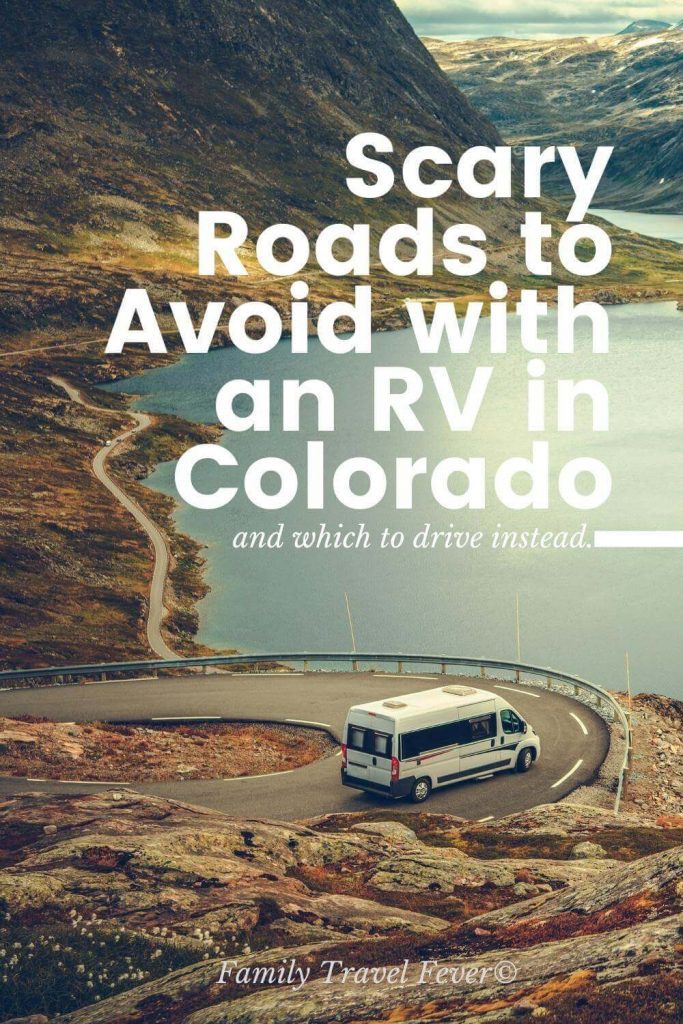
Final Thoughts about the Scary Roads You Must Avoid and the RV-friendly Routes in Colorado
Tourists and locals who haven’t been traveling with RVs often find Colorado roads shocking. Seriously, I just overheard someone talking about how terrifying Colorado mountain roads with no guardrails are. Especially if you are a flatlander who rarely sees hills, you might be surprised too. you’ll find that man of Colorado’s roads are steep and often pass through mountains and cliffs.
If you’re a beginner and don’t have much experience with driving through mountain passes and cliff trails, now this extensive list should help you plan your RV route better in Colorado.
Another option is to rent an RV from a local. Colorado locals are nice people and I assure you that they would be willing to give you tips on how to go through your trip. Check these resources for renting an RV.
- How to Rent an RV for an Epic Road Trip: Helpful Beginner’s Guide
- 25 Expert Tips for Renting an RV for the First Time
- RV Rental Delivery and Setup at Your Campsite (Cost, FAQs, Examples)
- 11 RV Rental Types Explained (+ Rental Cost and Length)
- 17 Key Questions to Ask Before Renting an RV for Your Family Vacation
If you need more ideas about RV destinations that are worth visiting, these posts can help:
- 9 Fantastic Places to Camp this April and May (+Map of Spring Camping 2021)
- 11 Patriotic Places to go Camping this Memorial Day Weekend (+Map and Discounts)
- 13 Campgrounds Near Grand Junction

Hi, I’m Shauna – Welcome to Family Travel Fever. We are a large family, that was bitten by the travel bug! I take the kids by myself because I don’t mind flying or driving solo with my crew to discover the coolest places.
Sign up for our email list for my best travel tips plus get the family travel planner free.

